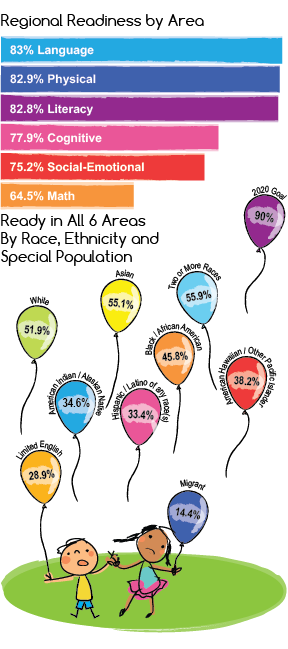Index and Glossary
- Ready & Successful Children
- Ready & Successful Families
- Ready & Successful Professionals
- Ready & Successful Schools
- Ready & Successful Communities & Systems

| Data Indicator | Island | San Juan | Skagit | Snohomish | Whatcom | State |
|---|---|---|---|---|---|---|
| K-12 enrollment, public schools 1 | 7,930 | 1,925 | 18,832 | 108,807 | 26,177 | 1,061,056 |
| Number of school districts 2 | 3 | 4 | 7 | 14 | 7 | 286 |
| Number of elementary schools 3 | 7 | 5 | 25 | 107 | 31 | 35,641 |
| Number of elementary schools particpating in WaKIDS 2014 4 | 1 | 3 | 19 | 41 | 24 | 623 |
| Kindergarten enrollment, public schools 5 | 603 | 144 | 1,465 | 7,892 | 1,940 | 81,206 |
| Districts that submitted kindergarten entry data (WaKIDS) Fall 2014 6 | 1 | 2 | 5 | 10 | 5 | 193 |
| Free & Reduced Lunch enrollment 7 | 38% | 45% | 52% | 38% | 41% | 45% |
| Transitional Bilingual – English Language Learners 8 | 204 | 93 | 2,690 | 10,350 | 1,775 | 102,339 |
| 3rd graders meeting or exceeding MSP/WASL math standards 9 | 64% | 73% | 60% | 67% | 64% | 65% |
| 3rd graders meeting or exceeding MSP/WASL reading standards 10 | 75% | 84% | 70% | 75% | 76% | 73% |
| Students from low-income households who graduated high school in four years 11 | 72% | 77% | 60% | 67% | 63% | 66% |
| # of districts in the region that accepted Regional PreK-K Transition Reports 12 | 3 | 3 | 5 | 11 | 7 | N/A |
 |
Source: Northwest Educational Service District 189, August 2015 |
1 Source: OSPI, 2014-15
2 Source: OSPI, 2014-15
3 Source: OSPI, 2014-15
4 Source: NWESD. Data retrieved from Teaching Strategies Gold for Fall 2014
5 Source: OSPI, 2014-15
6 Source: NWESD. Data retrieved from Teaching Strategies Gold for Fall 2014 Note: The Washington Kindergarten Inventory of Developing Skills (WaKIDS) is a process that helps to ensure a successful start to the K-12 experience. WaKIDS has three components: Family Connection welcomes families into the K-12 system as partners in their child’s education, Whole-Child Assessment gives kindergarten teachers information about the social and emotional, physical, cognitive and linguistic development of the children in their classrooms and Early Learning Collaboration, which aligns practices of early learning professionals and kindergarten teachers to support smooth transitions for children. Data Source: Numbers of WaKIDS participant districts are based on preliminary information from the Washington State Office of Superintendent of Public Instruction (OSPI) and includes those that voluntarily adopted into the program early (before they are required by the state).
7 Source: 2013 data from Annie E Casey Kids Count Data Center: Washington Office of Superintendent of Public Instruction (OSPI) Child Nutrition Services. The sources of this data are the annual October headcounts April 22, 2014. Note: The number and percent of students enrolled in public K-12 schools who applied for free or reduced price meals at their school. Data reflect only those enrolled students who applied as of October 1 of each year. These includes the number of students who applied and were eligible for free or reduced priced meals. These numbers do not necessarily reflect use of the service. The federal income eligibility guidelines are 135% FPL (poverty guide) for free school meals, and 185% FPL for reduced price school meals. These guidelines are available online.
8 Source: OSPI, 2014-2015 Note: A student is considered eligible for the Transitional Bilingual Instructional Program if they meet the following two conditions: 1) the language used most often used by student in his/her place of residence (not necessarily by parents, guardians, or others) or the first language that the student learned, and 2) English skills are sufficiently lacking or absent as to delay learning.
9 Source: Annie E Casey Kids Count Data Center: Data for this measure come from the Washington State Office of Superintendant of Public Instruction (OSPI). Data were retrieved on April 2, 2014 from the datafiles "MSP/HSPE Scores by District" and "MSP/HSPE Scores by State". Note: The percentage of third graders meeting WASL/MSP reading test standards for the school year. The Washington Assessment of Student Learning (WASL) is a test that reflects student knowledge based on the state’s Essential Academic Learning Requirements (EALRs). The WASL was administered to students in grades 3 through 10 from 1997 to 2009. It was replaced in 2010 by the state’s Measures of Student Progress (MSP) and the High School Proficiency Exam (HSPE). More information can be found online. This was the last year all schools used a common assessment.
10 Source: Annie E Casey Kids Count Data Center: Data for this measure come from the Washington State Office of Superintendant of Public Instruction (OSPI). Data were retrieved on April 2, 2014 from the datafiles "MSP/HSPE Scores by District" and "MSP/HSPE Scores by State". Note: The percentage of third graders meeting WASL/MSP math test standards for the school year. This was the last year all schools used a common assessment.
11 Source: OSPI: Low Income, 2013-2014 School Year 4-Year Adjusted Cohort, Class of 2014
12 Source: Northwest Educational Service District 189, August 2015
